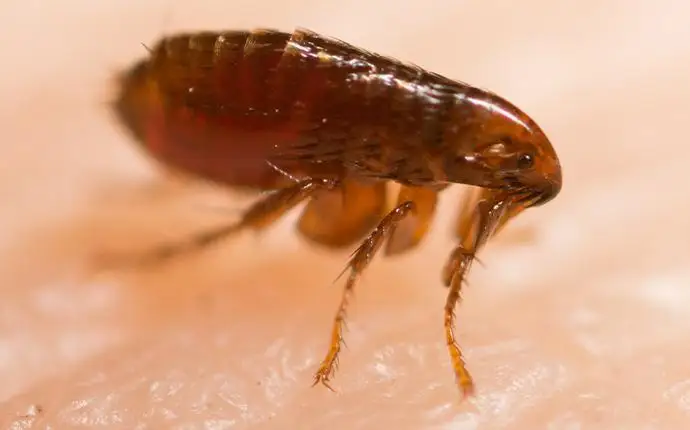Fleas
(Siphonaptera)
What are fleas?
Small wingless insects that feed on warm-blooded animals and humans, fleas are a type of ectoparasite. Ectoparasites feed on a host’s blood from the outside of their body, using specialized mouthparts to bite their host’s skin. The flea’s body has a hard shell that makes it difficult to squish. They have large, powerful back legs that allow them to jump to great heights, which helps them get onto a host or move out of danger.
Fleas feed on the blood of a variety of animals, including mice, rats, squirrels, rabbits, chipmunks, raccoons, and deer. While they prefer animal hosts, if people are available, or in the case of a large infestation, they’ll feed on our blood as well.
Are fleas dangerous?
Fleas are more annoying than dangerous. In the U.S., the spread of disease by fleas is not a huge concern. But, having fleas living in your yard or home is not an ideal situation and is something that should never be allowed. Pets that have fleas living on their bodies may itch excessively, have open sores, and experience hair loss. People and pets who are bitten by fleas sometimes have an allergic reaction to their saliva and may develop dermatitis. Secondary infections due to excessive itching at the bite sites are also common.
Why do I have a flea problem?
The warm, humid weather found in North Carolina allows fleas to thrive. It provides the perfect environment for their populations to explode. Fleas mainly live outside, but if they find their way into our homes, they are also able to breed and live successfully. A few fleas finding their way inside on your clothing, on the back of a pet, or in the fur of a rodent invader can lead to a large infestation. Outside, fleas are most problematic when the temperatures are between 70 and 90 degrees. Inside of our temperature-controlled homes, fleas can be a year-round problem. Check out this blog for more information: “Why Are There Fleas In My Raleigh Home?“.
Where will I find fleas?
Fleas feed and breed on the back of their host. Blood is their sole source of nutrition and allows them to complete their life cycle. After a female lays her eggs on a host, they roll off onto the ground where they develop into new fleas. Newly hatched fleas wait for a host to happen in damp, shady areas.
Outside, in the soil under decks, leaf piles, brush piles, and in areas of tall grass are places where people and animals may come into contact with fleas. Inside of homes and other structures, fleas are either found on the backs of pets or in places like bedding, upholstered furniture, and rugs.
How do I get rid of fleas?
Win the war against fleas and other pests with the help of an experienced professional. At Innovative Pest Solutions, we can provide fast and effective services that that home and business owners in the Raleigh, NC area can trust. We get rid of pests and stop them from coming back!
Protecting our customer’s home, health, and the environment are our top priorities. To learn more about our locally owned and operated company and our affordable pest solutions, reach out today! We will be happy to provide you with information about our residential pest control options.
How can I prevent fleas in the future?
To prevent fleas from becoming a problem on your Raleigh, North Carolina property, partner with Innovative Pest Solutions. Also, implement the following tips to guard your home against fleas:
- If you own pets, the best way to avoid a flea problem is to place them on a year-round flea control program under their veterinarian’s guidance.
- Remove things from your yard that fleas like to hide in like piles of leaves, brush piles, or excess woodpiles.
- Bathe and brush your pets on a routine basis, always on the lookout for fleas.
- Vacuum your home, not forgetting your upholstered furniture.
- Wash your bedding and any pet bedding located in your house regularly.
- Put into place a year-round pest control program that will keep rodents out of your home. Rodents are notoriously infested with fleas and introduce them into homes and other structures.
Helpful Flea Articles





